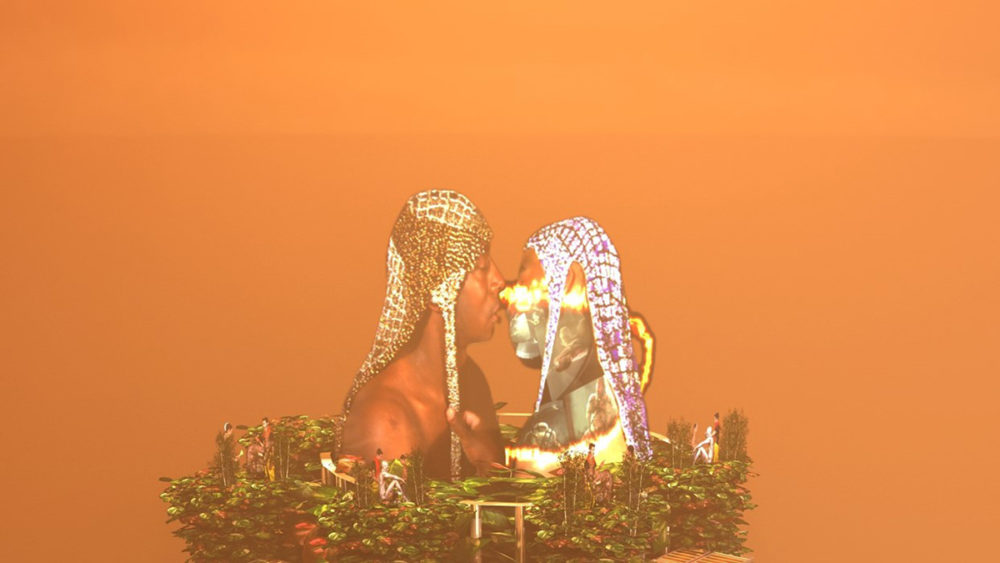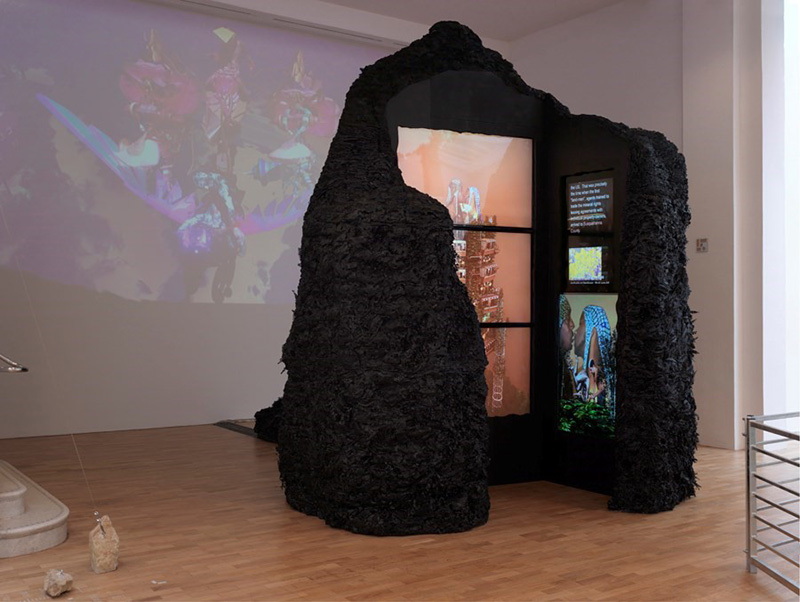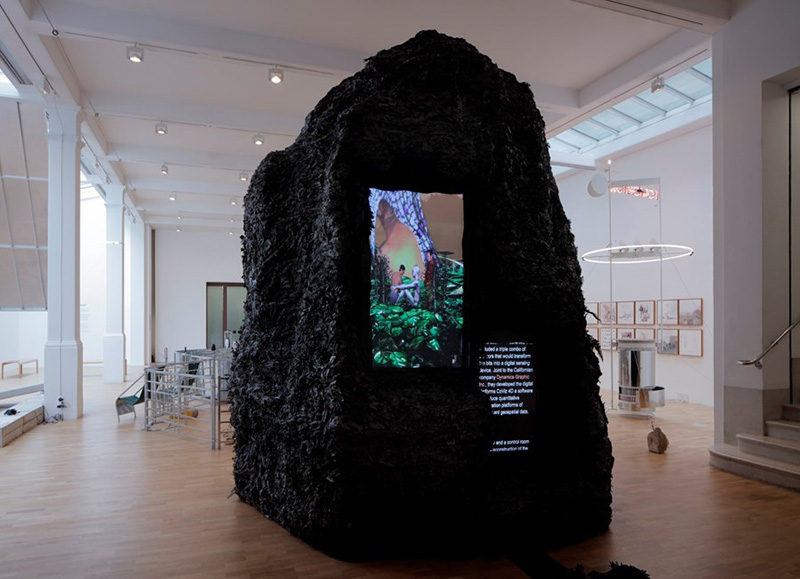
- Source: Dazed
- Author: Roisin McVeigh
- Date: April 01, 2019
- Format: DIGITAL
The artwork linking fracking, the climate crisis, and queer club culture
Artist Jacolby Satterwhite and architect Andrés Jaque consider a future where fracking, Grindr, and design babies reign supreme
In 1956, the architect and writer Theo Crosby had an idea to bring together a group of architects, artists, designers, and theorists to think about the future. The result was This is Tomorrow, a seminal exhibition at Whitechapel Gallery which saw 38 participants split into 12 cross-disciplinary groups. Coming at a time when Britain was still recovering from the trauma and destruction of World War II, the presence of pop art and new brutalism among the works signalled a cultural turning point in Britain. The nation was finally moving away from its post-war austerity and into a more modern society.
Sixty-three years later, Whitechapel Gallery has reimagined the landmark original, though things have taken a more dystopian turn. In a new show titled Is This Tomorrow? the London institution has paired together 10 international artists and architects to explore some of the 21st century’s most urgent issues. Two of these collaborators are Andrés Jaque and Jacolby Satterwhite. Jaque is an architect. In 2003 he founded the Office for Political Innovation, a transdisciplinary agency focused on architectural projects which bring “inclusivity into daily life”. Satterwhite’s artistic practice combines video, performance, 3D animations, and archival material to create multi-layered afro-futuristic environments. Most recently, he was a contributing director for Solange’s When I Get Home.
Their collaborative artwork, “Spirits Roaming the Earth”, uses developments in architecture and public space, such as fracking and the gentrification of queer culture in New York City, to give visibility to the often invisible effects of late capitalism. In connecting the dots between seemingly far-flung developments, the artists reveal the corrosive thread neoliberalism is weaving through society, eroding not just the natural environment, but also forms of community and human connection.
We spoke to collaborators Jaque and Satterwhite about the redistribution of power, what publicness means today and re-queering the future.

A still from Jacolby Satterwhite and Andrés Jaque’s “Spirits Roaming the Earth”
How did you prepare for the exhibition? In what ways were you influenced by the original This Is Tomorrow staged in 1956, if at all?
Andrés Jaque: The original This Is Tomorrow was part of a series of movements in the intersection of arts and architecture, to redefine the fields’ engagement with the environmental and the social as interdependent layers of reality. This interest in environment and science grew from a need felt by artists and architects, to make sense of a universe where the moon, the earth, nuclear power, and viruses were transforming what existence was about.
Today, we face a similar situation. The climate crisis and its association with the growth of inequality, the lack of agency among state bodies and massive planetary migrations, is again posing questions around how humans engage environmentally. We no longer share a universe. We inhabit multiverses that segregate us rather than unite us. This is the major difference our work operates in.
Jacolby Satterwhite: After studying the history of the exhibition and having a suite of meetings with Andrés, it became evident that the project would build itself naturally, because of the congruence of our work and the similarities in our conceptual threading. Like Andrés says, ‘We no longer share a universe. We inhabit multiverses’. Architects and visual artists today operate behind a lens that works with the multiverses no matter how disproportionate, attempting to force a proportionate relationship with these big and small ideas in today’s climate.
The work brings together the seemingly disparate subjects of queer desire and fracking, among others. What drew you to these topics in particular?
Andrés Jaque: Fracking in Susquehanna Valley, Pennsylvania grew so New York could transition from coal to natural gas. Fracking pollutes at the place where gas is extracted, but then it provides a gas that does not pollute at the place where it is burnt. By this simple process, New York found, in the last 15 years, a way to offshore its pollution to the poorer state of Pennsylvania.
As part of this, New York’s increasingly bluer skies became the site where a new real estate market was built. That of the ‘helicopter views’ money storage condos. These were built in the former locations of queerhoods. This development together with the arrival of hook up apps such as Grindr, ended up ‘dequeening’ and commodifying gay sex; to the extent that these new helicopter-view-hoods became the most desired locations for gay men to switch on their apps. Only through research did we manage to connect all these dots. This is the result of five years of intensive research that the Office for Political Innovation has been carrying out in fracking sites, in the Grindr offices in West Hollywood, and in cryobanks in New York and California. This is what cities like New York, London, and Los Angeles are becoming now, and this is what we feel we need to be confronting.
“Spirits Roaming the Earth” combines elements from both of your previous works, including Andrés’ “Sex and the so-called City”, while Jacolby’s animations present images of queer utopia and Afrofuturism that are familiar from previous work. How did the collaboration come about and how did you decide to bring these different elements together?
Jacolby Satterwhite: We were both introduced to each other by the curatorial team at Whitechapel Gallery. Our proceeding creative meetings allowed us to discover that we were naturally overlapping in our theoretical models. Andrés even cited and exhibited photographic relics of my Grindr/Visionaire collaborative project at the Standard Hotel in his architectural exhibition Sex and the So-Called City. This intersection made us want to further explore how our mediums’ mutual expressions could coincide and push those ideas. Expanding on Andrés’ notions about desire-production masking the toxic processes happening underneath the surface, I carried that train of thought into my 3D animation by rendering a hybrid skyscraper that veils and unveils the pleasures and poisons of capitalism.
Andrés Jaque: Over the last decade, we have both been focused on the way power is now being redistributed through the relocation and territorial sorting of toxicity (fracking) and the crafting of bodily evolutions by means of an array of technologies that include genetic manipulation and cosmetics, among others things. This is all fueled by advanced capitalist forms of desire-production, that in no way make the processes happening underneath the surface readable. We believe architecture’s responsibility consists of rendering those processes visible and providing platforms to intervene so that alternative responses and subversion can be introduced within. It is a form of public space making, at a time when it is not space that is at stake, but complex territorial and biopolitical processes. Politics does not happen in public squares, nowadays. If we believe in publicness, we need to render cryobanks, real state market, and fracking accountable. This is what we are doing at Whitechapel.
Andrés, can you talk about the term “highendcracy”, how did you first become interested in this area, and what is its relevance to this exhibition?
Andrés Jaque: Cheap forms of exclusivity replaced society’s pursuit of fairness. VIP, prechecking, premium, and members-only culture became the common ground in which we coexist. We have been studying projects which dispute this activity and helping many of them to become empowered in facing such social simplification hegemonies. For example, I’m fascinated by the intentionality of the community of Tween Oaks in Virginia. They are almost completely energy self-sufficient, they value domestic and child-raising labour as proper labour, and 10 per cent of the population identify themselves as gender fluid. This is only one case among many which show how much is being erased by the hegemony of what I started calling ‘highendcracy’.

“Spirits Roaming the Earth”, 2019, Jacolby Satterwhite and Andrés Jaque. Photography by Brotherton-Lock and courtesy of Whitechapel Gallery
The screens which host the work are contained in a mountainous structure of foliage, the blackened surface of which seems to be a dystopian representation of the Earth, perhaps covered in oil? At least, this was my observation. What was the importance of this setup? Is it intended as a kind of warning?
Andrés Jaque: It was crucial to introduce this discussion not through a technocratic or minimalistic aesthetic, but through one that provides access and connects it with a broad cultural context, allowing us to make sense of this complex reality which is participated in not only by the engineering advisors of gas companies but also through toys, videogames, or activists’ leaflets. These are the registers through which this is being collectively sensed. This is what we are part of. And from our own belonging to these cultural and political contexts, this is the point at which we want to intervene.
Jacolby Satterwhite: I particularly enjoyed how the blackened surface of the mountain resembles a decaying dental cavity being strained of its resources by the decadent excesses illustrated in the animation and footage displayed in the monitors installed within the mountain core.
Jacolby, you often utilise archives in your art. Can you explain the importance of this process for you, and how it helped to shape this work in particular?
Jacolby Satterwhite: I identify with the strategies of surrealist, Fluxus, and Dada artists who responded to the daunting political and media climate by making works of art that reject propaganda through the principles of gaming. When I say gaming I mean games of ‘chance’, ‘exquisite corpse’ style collaboration, performance, and interdisciplinary creation. I collect archives of performance, sound, stock imagery, and personal imagery, and produce architectural and object models in Maya, a 3D computer graphics application. This allows me to have a toy box to immerse in when mapping conceptual constellations to reveal what Andrés likes to call ‘the engagement between environmental, social, and political’ and how they spark forms that reveal greater truths.
Can you explain your interest in Grindr and how this research informed the work?
Jacolby Satterwhite: I was solicited by Visionaire and Grindr to do an intervention at the Standard Hotel a few years ago and it forced me to take an artistic distance and analyse what it really was. I realised I was funded by a corporation to create a film and digital art installation inside of a hotel that gentrified the queerhood Meatpacking District. My reaction involved wallpapering the entire room with 3D renderings of an imagined cruising site in Central Park and making it a performance studio for people to transgress and perform in. The party lasted from 7pm till 8 am in the morning, green screen ripped to shreds, but I had around 10 hours of documentation of vast array of New York darlings being drugged out, drunk, and queer for the camera. That archive of transgression has been utiliaed as a texture in my work for the past few years.

“Spirits Roaming the Earth”, 2019, Jacolby Satterwhite and Andrés Jaque. Photography by Brotherton-Lock and courtesy of Whitechapel Gallery
Your late mother Patricia is a constant presence throughout your work. How did she influence this piece, and how does she tie in with the ideas of it?
Jacolby Satterwhite: My mother is a primary case of what happens in the modern world when capitalism and media drive someone into mental chaos. Her body of architectural and utilitarian drawings are proposals for a practical future. Since she was the queen of double entendres within her writing, drawing, and singing language, I thought it was an obvious choice to have her music score the installation at Whitechapel Gallery.
Utopias and dystopias play an important role in both of your practices. That’s something that becomes clear here, as two opposing narratives appear to be in conversation with each other. One is a kind of surreal queer utopia, while the other presents factual research around the new sanitised urbanism of New York City, and feels quite dystopian. In an ideal world, what are your hopes for the future?
Andrés Jaque: It is interesting how architects and artists are often expected to produce pure new beginnings or solutions that will provide hope for the possibility that a momentous crisis will disappear in the near future. I really find that problematic. Architects are not balneary providers. The provision of spaces to escape and to avoid the confrontation with reality is what advanced capitalism is good at, there is no need to gather a bunch of clever architects, artists, and curators to do that.
We are here to operate within reality, not to provide the illusion of a future where our concerns will have disappeared by means of ‘smart’ simple operations. Our work is not dystopian or utopian. It simply intervenes in what exists. And in order to do that there is a need to engage in research. We are proposing a whole plan to re-queer the trans-scalar territories we exist by. Is it a more exciting, inclusive and fair scenario than the one we live now? Yes. Are those the political and aesthetic moves many of us defend that should be implemented? Yes. Is it green, toxicity-free, harmonised, and homogenised? Certainly not. Does it make it dystopian? No. It is reality being intervened.
Jacolby Satterwhite: I hope we resolve climate change and the socially cancerous aspects of the internet so I can live to old age as an artist.

